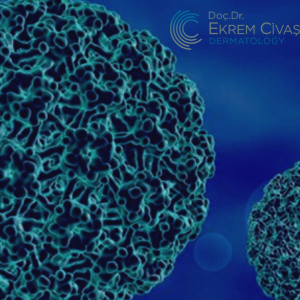
Sexually Transmitted Diseases
Contraction of Sexually Transmitted Diseases STDs is increasing day by day, therefore, it is important to educate people about the diagnosis and protection against STDs.
- Genital Herpes
- Vaginal discharge
- Urethral discharge
- Genital ulcers
- Chlamydia
- Syphilis
- Trichomoniasia
- Gonorrhea
- Genital warts
- AIDS (HIV infection)
Herpes Simplex
This is a common, chronic viral disease caused by Herpes Simplex Type 2 virus. The main symptom is presence of small groups of watery pimples and their explosive forms. It can affect sexual life and personal life. The open wound in the genital area increases the risk of contracting of HIV infection. Diagnosis is usually made clinically, but laboratory tests can be done when necessary. Treatment is planned for the first attack, recurring attack, and suppression.
Vaginal Discharge
It occurs quite often in women and much less in men. It causes itching, discharge, bleeding and pain. In some rare occasions it can cause abdominal pain, abnormal vaginal bleeding and fever. It is caused by bacteria, fungus and a parasite called trichomonias. Besides infection, it can also be caused by foreign body, cervical polyps and malignant conditions. It is diagnosed by examination and laboratory tests.
Urethral Discharge
Urethritis is the most common sexually transmitted disease in men and may be associated with cervicitis in women. Burning sensation and and discharge are the most common symptoms. Gonorrhea (known as gonorrhea), clamidia, ureaplasma, mycoplasma and, more rarely, T. vaginalis are among the main causing factors. A definite diagnosis can be made by a urine test. Treatment is by antibiotics.
Genital Ulcers
Syphilis, chancroid, herpes genitalis, trauma, dermatitis and drug eruptions are among the causes of genital acute ulcers. Chronic ulcers are more likely to occur due to Behcet’s disease, bullous diseases, inflammatory bowel disease (Crohn’s), herpes, and leprosy. Treatment is based on the cause.
Syphilis
It is one of the most common sexually transmitted diseases. In the primary infection stage, skin lesions, mucosal lesions and lymph nodes can be observed in the genital region. In a later stage it affects, cardiac, gomas and neurological organs. Diagnosis is done by a dark field microscopic examination of the lysine (discharge from the lesions), or blood tests. Non treponemal tests such as VDRL or RPR and treponemal tests such as FTA-ABS and TPHA are done. Non treponomic tests can be false negative, so they should bedone together with with treponmal tests. The treatment varies according to the stage in which the disease has reached. It is one of the most dangerous sexually transmitted diseases in terms of complications and imitating many diseases.
Trichomoniasis
This is one of the most common sexually transmitted infections. It causes foul-smelling yellow-green discharge in women and a burning sensation and prostatitis in men. It can be contagious before the symptoms are visible. It increases the risk of HIV transmission 2-3 times more. Diagnosis is by microscopic examination.
Gonorrhea
It is among the most common sexually transmitted diseases. In males the symptoms are burning sensation and discharge while in women there are no symptoms. Initially the discharge is milky. It spreads later in women, and can cause bleeding between periods. Diagnosis is by microscopic examination of the bacteria.
Genital warts
Genital warts or HPV is a virus that is known to have over 100 different types and can create up to 40 types warts in the genital area. Type 16 and Type 18 can cause cancer. In recent years, improved protection is recommended against certain types of HPV for 11-12 year olds.
HIV AIDS
HIV virus causes immunodeficiency which in turn causes AIDS. It an cause inflammation or infection-related cancers. So far there is no vaccination or treatment method that can control the disease. However antiretroviral therapy is used for life which improves the quality of life and prolongs life span. With early detection when the symptoms are not evident yet, patients can live normal lives through aniretroviral treatments. Not all patients with HIV infections develop to AIDS. Symptoms are similar to normal viral diseases such as fever, fatigue, skin rash, night sweats, muscle aches, swollen lymph nodes and mouth sores. These symptoms are seen 2-4 weeks after the infection with the virus and may not be seen in everyone. The disease then passes through a silent cycle and then develops to the final phase. This period is devastating in patients who do not observe treatment. Quick and serious weight loss, night sweats, unexplained fatigue, diarrhea, sores in the mouth and genital area, and neurological symptoms.

